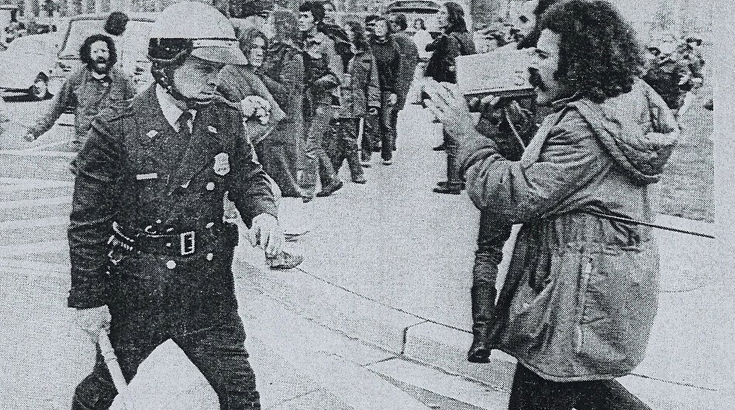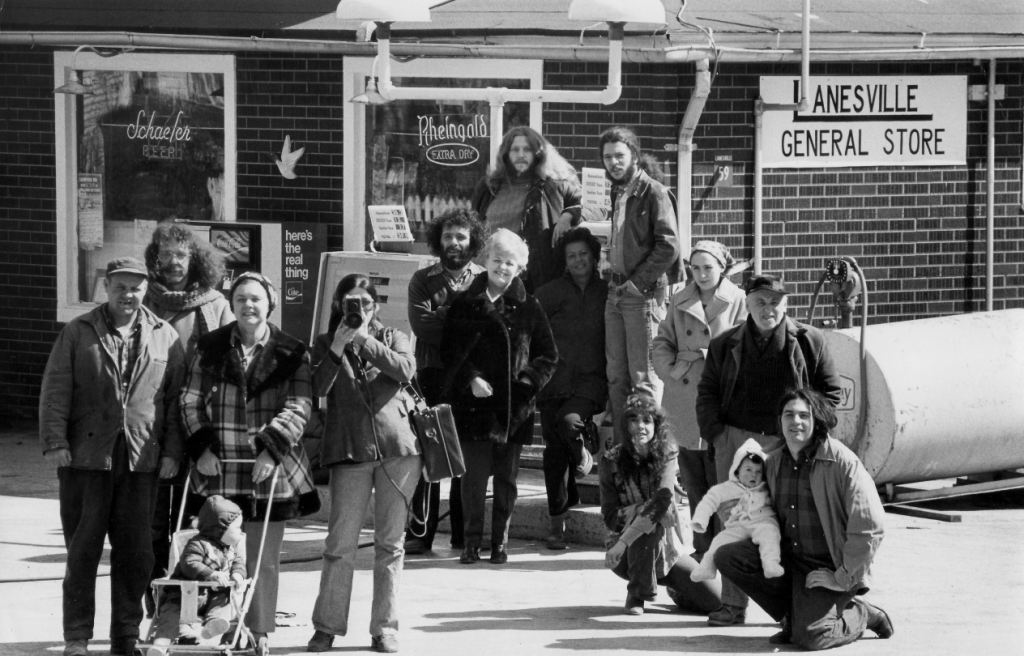In the documentary film “Here Come the Videofreex”, many things said felt strangely relatable and applicable even to the social broadcasting situation of today. There is a striking similarity in the way the Videofreex were running about with portapaks in hand and us, almost 50 years later, with our smartphones today. The desire for personalized content (video tapes of happenings in the past vs social media today) and stigma of manipulative television from main TV networks remain.
 David Cort shooting ‘Mayday Realtime’ http://www.sva.edu/events/archive/were-all-videofreex
David Cort shooting ‘Mayday Realtime’ http://www.sva.edu/events/archive/were-all-videofreex
One of the scenes in the video featured an informal interview with Fred Hampton, the chairman of the Black Panther Party, where he discussed about the corruption in the government and expressed his desire to educate and lead the people. He was murdered by the police shortly after, but the tape remained in existence even up till today, as proof of his character despite the political situation at the time. Their work served not only as entertainment for the people in the past, but as historical archives documenting bits and pieces of protests and strikes, from their unique perspectives and participants that would never have been shown on mainstream TV. They gave a voice to the ordinary people of the community and the chance for their opinions (be it towards the government or about mundane everyday things) to be heard. As opposed to TV networks featuring reporters reading off scripts in specific locations, the footage recorded by the Videofreex were raw and showed nothing but the truth.
Their work opened up new perspectives and unfiltered channels in which people can have access to a different side of the story. Their relentless search for content and broadcasting means, and eventual success in building their own pirated TV network was a huge step towards the future of broadcasting.
 Videofreex and their neighbours at Lanesville gerneral store http://www.rollmagazine.com/videofreex-at-the-dorksy/
Videofreex and their neighbours at Lanesville gerneral store http://www.rollmagazine.com/videofreex-at-the-dorksy/
Instead of the traditional one-to-many broadcasting, Videofreex was one of the first collectives to open doors to two(or more)-way communication in broadcasting. It appears the birth of the third space was in Lanesville, 1972. During their tv broadcasts in Lanesville, people could call in through the radio and provide feedback about the broadcast in real time, and further interaction is encouraged through it. With this addition channel for interaction, there is an increased level of engagement in the broadcasted content, and perhaps build and stronger trust in the tight-knit community of Lanesville. The establishment of remote two-way communication through television and radio at that time was indeed a huge achievement, sharing similarities with the comment and ‘like’ functions of Instagram and Facebook Live of today.
References:
https://videofreex.com/
http://www.rollmagazine.com/videofreex-at-the-dorksy/
http://www.vdb.org/titles/lanesville-tv-overview-i


Very good! I was particularly struck by this comment: “They gave a voice to the ordinary people of the community and the chance for their opinions (be it towards the government or about mundane everyday things) to be heard.” That is precisely what they introduced with their use of independent media, how it could be used for personal expression. Now the question is: with the extraordinary social media tools we have today, are we taking full advantage of them in the way that the Videofreex did? Or do we take them for granted? What can we do today to define our distinct role as independent media artists and broadcasters in our use of social media, rather than just using it for diversion and entertainment?
Also, be sure your links are embedded so you can click on them.